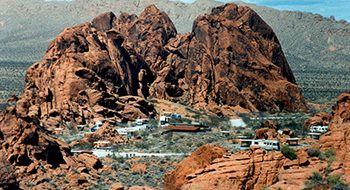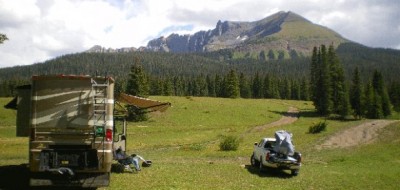By Bob Difley
Freightliner is continuing to introduce alternative-power products for the commercial vehicle industry with the introduction of its highly anticipated plug-in all-electric walk-in van (WIV) chassis. The new chassis model is the only one domestically engineered and the first in the industry to be completely all-electric (includes HVAC system) in North America.
The all-electric chassis, developed in partnership with Enova Systems, a leading developer and producer of electric vehicles and hybrid-electric drive system technologies for commercial vehicle OEMs, is built on the Freightliner MT-45 WIV chassis platform. On select delivery and service routes, Freightliner’s studies showed a 100 mile range on a single charge and that customers could save up to $15,000 per electric vehicle annually compared with traditionally powered walk-in vans.
Freightliner presented the pre-production all-electric WIV chassis model at the 2010 National Truck Equipment Association (NTEA) Work Truck Show.
Freightliner designed this truck from the ground up and is going after the walk-in van market though itis another step toward electric powered RVs, admittedly still years away. But what would prove beneficial to the RV market would be acceptance by the walk-in van market, enabling mass production and a lowering of costs by the time it reaches motorhome manufacturers. Freightliner introduced the first hybrid-electric Class A motorhome chassis in December 2008.
Check out my eBook, BOONDOCKING: Finding the Perfect Campsite on America’s Public Lands, for tips on finding the ultimate in RVing and camping freedom.



Pingback: url
Tom Yancy
I’m curious about battery waste I feel that there be no end to this. Kind like nuk. waste. Thing of all the batteries that are built what you going to do with it all .One time are another all these billions of batteries wil all end up in a hole, some where someone is going to have strange looking children what next. Does anyone think things out?
Pingback: discount bedroom furniture
chris
Me and my dad recently set up a magnet power generator our house. It was pretty easy and only took about 2 hours to set up. My dad said hes saving a lot now on the electricity bill for only 2 hours of work. the instructions to build one were pretty simple and easy to follow. We got them through here http://a2b60br4s0bz8pb6fb086-1d3o.hop.clickbank.net/?tid=2010 . I definitely recommend magnetizing your home, it’s good for the environment (using less electricity) and saves you a lot of money on the bills.
Vegasdan
This article by the U.S. Geological Survey kind of puts the need for developing alternative ways to get us down the road. If the environmentalists will move over, I’ll take reliable, abundant oil over battery power any day.
3 to 4.3 Billion Barrels of Technically Recoverable Oil Assessed in North Dakota and Montana’s Bakken Formation—25 Times More Than 1995 Estimate—
Released: 4/10/2008 2:25:36 PM
Contact Information:
U.S. Department of the Interior, U.S. Geological Survey
Office of Communication
119 National Center
Reston, VA 20192 Main Contact
Phone: N/A
——————————————————————————–
Reston, VA – North Dakota and Montana have an estimated 3.0 to 4.3 billion barrels of undiscovered, technically recoverable oil in an area known as the Bakken Formation.
A U.S. Geological Survey assessment, released April 10, shows a 25-fold increase in the amount of oil that can be recovered compared to the agency’s 1995 estimate of 151 million barrels of oil.
3 to 4.3 Billion Barrels of Oil in North Dakota and Montana
Technically recoverable oil resources are those producible using currently available technology and industry practices. USGS is the only provider of publicly available estimates of undiscovered technically recoverable oil and gas resources.
New geologic models applied to the Bakken Formation, advances in drilling and production technologies, and recent oil discoveries have resulted in these substantially larger technically recoverable oil volumes. About 105 million barrels of oil were produced from the Bakken Formation by the end of 2007.
The Bakken Formation estimate is larger than all other current USGS oil assessments of the lower 48 states and is the largest “continuous” oil accumulation ever assessed by the USGS. A “continuous” oil accumulation means that the oil resource is dispersed throughout a geologic formation rather than existing as discrete, localized occurrences. The next largest “continuous” oil accumulation in the U.S. is in the Austin Chalk of Texas and Louisiana, with an undiscovered estimate of 1.0 billions of barrels of technically recoverable oil.
“It is clear that the Bakken formation contains a significant amount of oil – the question is how much of that oil is recoverable using today’s technology?” said Senator Byron Dorgan, of North Dakota. “To get an answer to this important question, I requested that the U.S. Geological Survey complete this study, which will provide an up-to-date estimate on the amount of technically recoverable oil resources in the Bakken Shale formation.”
The USGS estimate of 3.0 to 4.3 billion barrels of technically recoverable oil has a mean value of 3.65 billion barrels. Scientists conducted detailed studies in stratigraphy and structural geology and the modeling of petroleum geochemistry. They also combined their findings with historical exploration and production analyses to determine the undiscovered, technically recoverable oil estimates.
USGS worked with the North Dakota Geological Survey, a number of petroleum industry companies and independents, universities and other experts to develop a geological understanding of the Bakken Formation. These groups provided critical information and feedback on geological and engineering concepts important to building the geologic and production models used in the assessment.
Five continuous assessment units (AU) were identified and assessed in the Bakken Formation of North Dakota and Montana – the Elm Coulee-Billings Nose AU, the Central Basin-Poplar Dome AU, the Nesson-Little Knife Structural AU, the Eastern Expulsion Threshold AU, and the Northwest Expulsion Threshold AU.
At the time of the assessment, a limited number of wells have produced oil from three of the assessments units in Central Basin-Poplar Dome, Eastern Expulsion Threshold, and Northwest Expulsion Threshold.
The Elm Coulee oil field in Montana, discovered in 2000, has produced about 65 million barrels of the 105 million barrels of oil recovered from the Bakken Formation.
Results of the assessment can be found at http://energy.usgs.gov.
Floyd Reb
The RV of the future. At 76 and a life time RV’er, I can still dream. Try this. Electric hub wheels (like used with the largest earth movers on earth (R.G. LeTourneau) for years. No loss of energy through gears. A power supply by BLOOM ENERGY and Air Stream type house/flame. All light weight Aluminum. At present, the power supply would need to be pulled perhaps on a two wheel trailer and sell the excess power to the grid.
Ronald
As I see the advancement of trailers and rv’s, it seems to me that people took what was avaliable to them at that point in time and adapted them to camp out of. If I remember correctly, some of those early “rv’s” looked very much like motorized adaptations to the old chuck wagons used on cattle ranches and cattle drives! I don’t remember any pictures or records of those early “rv’s” that were anything the size that we have now. Is there even the SLIGHTEST possibilty that the work that Bob has pointed out over the past several post COULD lead to a new generation of “rv’s” that are more energy efficient than what we have now? Just wondering!!
Joe
I’m glad you’re at least thinking about it.
For the record, I didn’t base my facts on technology that exists now. I imagined a super duper battery that is 10 TIMES better than anything we have in the best electric cards right now (Tesla roadster) AND completely ignored the cost.
Keep an eye out for liquefied natural gas.
Bob Difley
You offer a lot of information for thought. However, I am factoring in the technological advancement of battery types, size reduction, improvement of charging times, and that manufacturers of delivery van sized trucks are now producing electric vehicles. These would be the same size as a typical Class B motorhome and would most likely carry more weight, yet the mags. feel that all-electric is a viable solution. And there are large electric busses now operating in Toronto and some other large cities proving that large electric vehicles–if the tests continue positive–are also viable. I would agree with you if you based your facts on the technology that exists right now, but the tech. is moving ahead fast, and foreign countries are investing lots of money in the sector and are getting the jump on America in electric vehicle technology. If the physics were against this happening, the investment dollars would not be flowing to the inventors and entrepreneurs.
Joe
My guess is that you are not surprised to read that I don’t see electric delivery vehicles as a first step towards an electric RV. I just can’t understand why you keep saying that they are. Since I don’t understand where you are coming from, let me try to explain my point of view.
Any vehicle has to store enough energy to carry it from point A to B. Batteries are one way to store that energy. Gas or Diesel is another way. Natural Gas is a way. Hydrogen is a way. They all have their pros and cons. Some weigh more than others (batteries), some take up a lot of space (batteries), some emit CO2, some stink, some explode, etc…..
To build an electric RV, you have to carry a lot of weight some long distance. You need a way to store power, and a way to use that power (an engine). Batteries are simply TOO BIG and TOO HEAVY to store the amount of power needed.
Think about your current RV fuel tank. How much does it weigh?
Gasoline carries around 10 calories of energy per gram. THIS (the amount of energy carried per amount of weight). A car battery carries about .03 calories per gram. That’s less than 1/300th of the energy for the same weight. You can carry 5 lbs of gasoline, or more than 1500lbs of car battery to store the same amount of energy.
Computer batteries (expensive, cutting edge, like the Tesla roadster) do better than car batteries. They carry around .1 calories per gram. Comparing again to our 5lbs of gas, you would need 500lbs of battery to store the same energy.
Even if we improve batteries by a factor of 10 (again ignoring the cost of those batteries or the space they take up) you will need 50lbs of new super battery to equal the energy in 5lbs of gas.
1 gallon of gas weighs a little more than 6.2lbs. For an RV that carries 50 gallons, that’s 310 lbs. To get the same energy from our new super duper ten times better than current batteries battery, we would need more than 3000lbs of battery. 310lbs of gas fits into a reasonable amount of space for an RV. 3000lbs does not! The problems get worse when you consider the extra power needed to push the extra weight and the impact of chassis strength (and weight), tires and axles, etc….
If you want to look at the first step towards some future RV, keep an eye out for Hydrogen or Natural gas. Hydrogen holds more than twice as much energy per gram as gasoline, but takes up a ton of space. It also need to be manufactured from some energy source (coal, nuclear, whatever). Natural gas holds about 30% more energy per gram than gasoline. It has it’s own set of problems (emissions, wells).
Hydrogen buses are on the road right now (with expense and fuel availability problems), as are Semi’s powered by liquefied natural gas (with fuel availability problems too).
To see any potential future for alternative fuel RV’s, you need to look up (to trucks and buses), and not down to local delivery vans. You’re doing your readers a disservice by not understanding the space and weight problems with large battery powered vehicles.
My guess……look for a system of hydrogen or LNG fuel stations for 18 wheelers sometime down the line. RV’s will use those.
The Electric RV is a pipe dream. The laws of physics make it so.